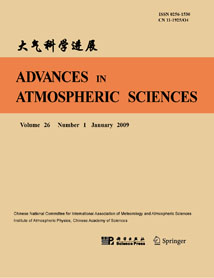| [1] |
Jing YANG, Gaopeng LU, Ningyu LIU, Haihua CUI, Yu WANG, Morris COHEN,
2017: Analysis of a Mesoscale Convective System that Produced a Single Sprite, ADVANCES IN ATMOSPHERIC SCIENCES, 34, 258-271.
doi: 10.1007/s00376-016-6092-0
|
| [2] |
Yali LUO, Weimiao QIAN, Yu GONG, Hongyan WANG, Da-Lin ZHANG,
2016: Ground-Based Radar Reflectivity Mosaic of Mei-yu Precipitation Systems over the Yangtze River-Huaihe River Basins, ADVANCES IN ATMOSPHERIC SCIENCES, 33, 1285-1296.
doi: 10.1007/s00376-016-6022-1
|
| [3] |
LIPING LUO, Ming Xue, Xin Xu, Lijuan Li, Qiang Zhang, Ziqi Fan,
2024: Understanding Simulated Causes of Damaging Surface Winds in a Derecho-Producing Mesoscale Convective System near the East China Coast based on Convection-Permitting Simulations, ADVANCES IN ATMOSPHERIC SCIENCES.
doi: 10.1007/s00376-024-3314-8
|
| [4] |
SUN Jianhua, ZHAO Sixiong, XU Guangkuo, MENG Qingtao,
2010: Study on a Mesoscale Convective Vortex Causing Heavy Rainfall during the Mei-yu Season in 2003, ADVANCES IN ATMOSPHERIC SCIENCES, 27, 1193-1209.
doi: 10.1007/s00376-009-9156-6
|
| [5] |
Changhai LIU,
2005: A Numerical Investigation of a Slow-Moving Convective Line in a Weakly Sheared Environment, ADVANCES IN ATMOSPHERIC SCIENCES, 22, 625-639.
doi: 10.1007/BF02918706
|
| [6] |
Zhiwei HE, Qinghong ZHANG, Jun SUN,
2016: The Contribution of Mesoscale Convective Systems to Intense Hourly Precipitation Events during the Warm Seasons over Central East China, ADVANCES IN ATMOSPHERIC SCIENCES, 33, 1233-1239.
doi: 10.1007/s00376-016-6034-x
|
| [7] |
CHU Kekuan, TAN Zhemin, Ming XUE,
2007: Impact of 4DVAR Assimilation of Rainfall Data on the Simulation of Mesoscale Precipitation Systems in a Mei-yu Heavy Rainfall Event, ADVANCES IN ATMOSPHERIC SCIENCES, 24, 281-300.
doi: 10.1007/s00376-007-0281-9
|
| [8] |
CHEN Min, ZHENG Yongguang,
2004: Vorticity Budget Investigation of a Simulated Long-Lived Mesoscale Vortex in South China, ADVANCES IN ATMOSPHERIC SCIENCES, 21, 928-940.
doi: 10.1007/BF02915595
|
| [9] |
ZHAO Sixiong, BEI Naifang, SUN Jianhua,
2007: Mesoscale Analysis of a Heavy Rainfall Event over Hong Kong During a Pre-rainy Season in South China, ADVANCES IN ATMOSPHERIC SCIENCES, 24, 555-572.
doi: 10.1007/s00376-007-0555-2
|
| [10] |
Ji-Hyun HA, Hyung-Woo KIM, Dong-Kyou LEE,
2011: Observation and Numerical Simulations with Radar and Surface Data Assimilation for Heavy Rainfall over Central Korea, ADVANCES IN ATMOSPHERIC SCIENCES, 28, 573-590.
doi: 10.1007/s00376-010-0035-y
|
| [11] |
Anjing HUANG, Gaopeng LU, Hongbo ZHANG, Feifan LIU, Yanfeng FAN, Baoyou ZHU, Jing YANG, Zhichao WANG,
2018: Locating Parent Lightning Strokes of Sprites Observed over a Mesoscale Convective System in Shandong Province, China, ADVANCES IN ATMOSPHERIC SCIENCES, 35, 1396-1414.
doi: 10.1007/s00376-018-7306-4
|
| [12] |
Qi LI, Fengxia GUO, Xiaoyu JU, Ze LIU, Mingjun GAN, Kun ZHANG, Binbin CAI,
2023: Estimation of Lightning-Generated NOx in the Mainland of China Based on Cloud-to-Ground Lightning Location Data, ADVANCES IN ATMOSPHERIC SCIENCES, 40, 129-143.
doi: 10.1007/s00376-022-1329-6
|
| [13] |
Wanli LI, Xiushu QIE, Shenming FU, Debin SU, Yonghai SHEN,
2016: Simulation of Quasi-Linear Mesoscale Convective Systems in Northern China: Lightning Activities and Storm Structure, ADVANCES IN ATMOSPHERIC SCIENCES, 33, 85-100.
doi: 10.1007/s00376-015-4170-3
|
| [14] |
Manman MA, Xiaogang HUANG, Jianfang FEI, Chi ZHANG, Chao LI, Xiaoping CHENG,
2022: Analysis of the Winter Cloud-to-Ground Lightning Activity and Its Synoptic Background in China during 2010–20, ADVANCES IN ATMOSPHERIC SCIENCES, 39, 985-998.
doi: 10.1007/s00376-021-1260-2
|
| [15] |
Ji Yang, Kun Zhao, Ping Song, Long Wen, Fanchao Lyu, Jie Ming, Yuanyuan Zhen,
2024: The Evolution of Microphysical Structures and Cloud-to-ground Lightning in A Deep Compact Thunderstorm over the Nanjing Area, ADVANCES IN ATMOSPHERIC SCIENCES.
doi: 10.1007/s00376-024-3377-6
|
| [16] |
Fan Beifen, Ye Jiadong, William R. Cotton, Gregory J. Tripoli,
1990: Numerical Simulation of Microphysics in Meso-β-Scale Convective Cloud System Associated with a Mesoscale Convective Complex, ADVANCES IN ATMOSPHERIC SCIENCES, 7, 154-170.
doi: 10.1007/BF02919153
|
| [17] |
Dong ZHENG, Yijun ZHANG, Qing MENG, Luwen CHEN, Jianru DAN,
2016: Climatology of Lightning Activity in South China and Its Relationships to Precipitation and Convective Available Potential Energy, ADVANCES IN ATMOSPHERIC SCIENCES, 33, 365-376.
doi: 10.1007/s00376-015-5124-5
|
| [18] |
Yang LI, Yubao LIU, Rongfu SUN, Fengxia GUO, Xiaofeng XU, Haixiang XU,
2023: Convective Storm VIL and Lightning Nowcasting Using Satellite and Weather Radar Measurements Based on Multi-Task Learning Models, ADVANCES IN ATMOSPHERIC SCIENCES, 40, 887-899.
doi: 10.1007/s00376-022-2082-6
|
| [19] |
Huaming ZHANG, Yijun ZHANG, Weitao LYU, Yang ZHANG, Qi QI, Yanfeng FAN,
2019: Analysis of the Spectral Characteristics of Triggered Lightning, ADVANCES IN ATMOSPHERIC SCIENCES, 36, 1265-1272.
doi: 10.1007/s00376-019-9006-0
|
| [20] |
Yanqing Gao, Xiaofeng Wang, Wei Guo,
2024: Impact of Assimilating FY-4A Lightning Data with a Latent Heat Nudging Method on Short-Term Forecasts of Severe Convective Events in Eastern China, ADVANCES IN ATMOSPHERIC SCIENCES.
doi: 10.1007/s00376-024-3339-z
|















 AAS Website
AAS Website 
 AAS WeChat
AAS WeChat 
 DownLoad:
DownLoad: